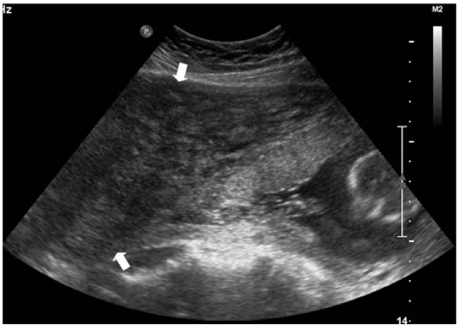Korean J Obstet Gynecol.
2010 Jan;53(1):70-74. 10.5468/kjog.2010.53.1.70.
Preterm delivery in a primigravida with uterine adenomyosis
- Affiliations
-
- 1Division of Maternal and Fetal Medicine, Department of Obstetrics and Gynecology, Konkuk University Medical Center, Seoul, Korea. hwanghs@kuh.ac.kr
- KMID: 2077963
- DOI: http://doi.org/10.5468/kjog.2010.53.1.70
Abstract
- Adenomyosis has been well known to be associated with infertility, spontaneous rupture of the uterus during labor in a primiparous woman, spontaneous preterm labor, preterm premature rupture of membranes (PPROM), and delayed postpartum hemorrhage. We recently experienced a case of preterm delivery at 29 gestational weeks in a primigravid woman with uterine adenomyosis. We report the case of preterm delivery accompanied by various complications such as uncontrolled pain, preterm labor, and oligohydramnios in a woman with uterine adenomyosis.
Keyword
MeSH Terms
Figure
Reference
-
1. Frankl O. Adenomyosis uteri. Am J Obstet Gynecol. 1925. 10:680–684.2. Bird CC, McElin TW, Manalo-Eslrella P. The elusive adenomyosis of the uterus - revisited. Am J Obstet Gynecol. 1972. 112:583–593.3. Parazzini F, Vercellini P, Panazza S, Chatenoud L, Oldani S, Crosignani PG. Risk factors for adenomyosis. Hum Reprod. 1997. 12:1275–1279.4. Curtis KM, Hillis SD, Marchbanks PA, Peterson HB. Disruption of the endometrial-myometrial border during pregnancy as a risk factor for adenomyosis. Am J Obstet Gynecol. 2002. 187:543–544.5. Kissler S, Hamscho N, Zangos S, Wiegratz I, Schlichter S, Menzel C, et al. Uterotubal transport disorder in adenomyosis and endometriosis--a cause for infertility. BJOG. 2006. 113:902–908.6. Kunz G, Beil D, Huppert P, Noe M, Kissler S, Leyendecker G. Adenomyosis in endometriosis- prevalence and impact on fertility. Evidence from magnetic resonance imaging. Hum Reprod. 2005. 20:2309–2316.7. Bensaid F, Kettani F, el Fehri S, Chraibi C, Alaoui MT. Obstetrical complications of adenomyosis. Literature review and two case reports. J Gynecol Obstet Biol Reprod (Paris). 1996. 25:416–418.8. Mueller MD, Saile G, Brühwiler H. Spontaneous uterine rupture in the 18th week of pregnancy in a primigravida patient with adenomyosis. Zentralbl Gynakol. 1996. 118:42–44.9. Juang CM, Chou P, Yen MS, Twu NF, Horng HC, Hsu WL. Adenomyosis and risk of preterm delivery. BJOG. 2007. 114:165–169.10. Wang PH, Pang YP, Chao HT, Lai CR, Juang CM, Yuan CC, et al. Delayed postpartum hemorrhage in adenomyosis: a case report. Zhonghua Yi Xue Za Zhi (Taipei). 1998. 61:492–495.11. Sheiner E, Bashiri A, Levy A, Hershkovitz R, Katz M, Mazor M. Obstetric characteristics and perinatal outcome of pregnancies with uterine leiomyomas. J Reprod Med. 2004. 49:182–186.12. Lev-Toaff AS, Coleman BG, Arger PH, Mintz MC, Arenson RL, Toaff ME. Leiomyomas in pregnancy: sonographic study. Radiology. 1987. 164:375–380.13. Kim SH, Kim JK, Chae HD, Kim CH, Kang BM. Rapidly growing adenomyosis during the first trimester: magnetic resonance images. Fertil Steril. 2006. 85:1057–1058.14. Katz VL, Dotters DJ, Droegemueller W. Complications of uterine leiomyomas in pregnancy. Obstet Gynecol. 1989. 73:593–596.15. Neiger R, Sonek JD, Croom CS, Ventolini G. Pregnancy-related changes in the size of uterine leiomyomas. J Reprod Med. 2006. 51:671–674.16. Aharoni A, Reiter A, Golan D, Paltiey Y, Scharf M. Patterns of growth of uterine leiomyomas during pregnancy: a prospective longitudinal study. Br J Obstet Gynaecol. 1988. 95:510–513.17. Muram D, Gillieson M, Walters JH. Myomas of the uterus in pregnancy: ultrasonographic follow-up. Am J Obstet Gynecol. 1980. 138:16–19.18. Skrablin S, Banović V, Kuvacić I. Successful pregnancy outcome in a woman with large uterine intramural myoma. Eur J Obstet Gynecol Reprod Biol. 2005. 118:115–116.19. Exacoustòs C, Rosati P. Ultrasound diagnosis of uterine myomas and complications in pregnancy. Obstet Gynecol. 1993. 82:97–101.20. Qidwai GI, Caughey AB, Jacoby AF. Obstetric outcomes in women with sonographically identified uterine leiomyomata. Obstet Gynecol. 2006. 107(2 Pt 1):376–382.21. Coronado GD, Marshall LM, Schwartz SM. Complications in pregnancy, labor, and delivery with uterine leiomyomas: a population-based study. Obstet Gynecol. 2000. 95:764–769.22. Davis JL, Ray-Mazumder S, Hobel CJ, Baley K, Sassoon D. Uterine leiomyomas in pregnancy: a prospective study. Obstet Gynecol. 1990. 75:41–44.
- Full Text Links
- Actions
-
Cited
- CITED
-
- Close
- Share
- Similar articles
-
- Recurrent Cerebral Infarction Associated with Uterine Adenomyosis
- Current status of high-intensity focused ultrasound for the management of uterine adenomyosis
- Antenatal and Delivery Outcomes in Twin Pregnant Women after Uterine Adenomyo mectomy: Summary of 5 Cases
- Monochorionic twin delivery after conservative surgical treatment of a patient with severe diffuse uterine adenomyosis without uterine rupture
- Are Transvaginal Sonography and Color doppler findings Useful for the Diagnosis of Adenomyosis?




